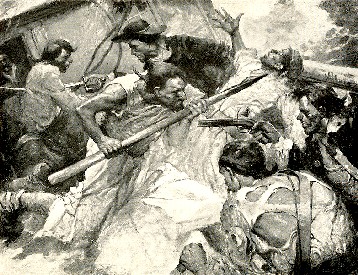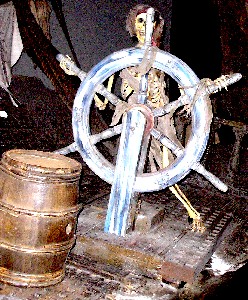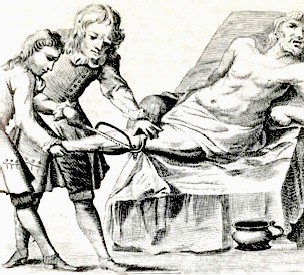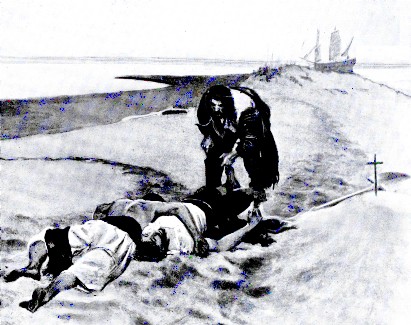
History of Pirate Surgeons Menu: 1 2 3 4 5 6 7 8 9 10 11 12 Next>>
The History of Sea and Pirate Surgeons, Page 6
Sea-Surgeons and Golden Age Pirates
We now come to the men who were actually, identifiably pirate surgeons. Until now we could only speculate about surgeons working with pirates throughout history because so little was known about the pirates themselves. While we do know of surgeons working with the English sea-dogs and buccaneers, these men cannot fairly be called pirate surgeons because the sea dogs and the buccaneers usually skirted the edges of piracy without delving into lawlessness. It was not until the golden age of piracy, which we will define as being from 1690 to 1725, that we find true pirate surgeons.

Artist: Ralph Delahaye Paine
Artist's Conception of Battle - Perhaps overstating dangers at sea
If a regular seaman's life was dangerous, a pirate's life was doubly so. On top of the normal potential for danger while working a tall ship, pirates were in a dangerous profession where battle was an ever-present possibility. As pirate captain Bartholomew Roberts put it, "A merry Life and a short one, shall be my Motto."1
If piracy wasn't dangerous enough in and of itself, author Charles Johnson tells us that while stitching up pirate Captain Edward Low's face after he had been accidentally cut during a skirmish, "the Surgeon [was] tollerably drunk, as it was customary for every Body to be".2 Imagine being 'tolerably drunk' with all the potential dangers of the ship, the sea and sea battles.
Since their work was so dangerous, pirates, like the buccaneers before them, offered insurance against wounds received in battle. We have three sets of Pirates Articles (or rules) from golden age of piracy from Captain Charles Johnson's books and all of them mention compensation for wounds incurred on the job, indicating how important this was to the men who joined them. Bartholomew Robert's article IX notes that if "any Man should lose a Limb, or become a Cripple in their Service, he was to have 800 Dollars, out of the publick Stock and for lesser Hurts, proportionably."3

Photo: Deror Avi
Disney - Definitely overstating dangers at sea
George Lowther's article 6 states "He that shall have the Misfortune to lose a Limb in Time of Engagement, shall have the Sum of one hundred and fifty Pounds Sterling, and remain with the Company as long as he shall think fit."4 Pirate captain John Phillip's article 8 says "If any Man shall lose a Joint in time of an Engagement shall have 400 Pieces of Eight, if a Limb 800."5
You may wonder at all this concern over wounding. It had much to do with a sailor's need to be able to get around, to climb stairs as well as the rigging on a ship. Sailors had to be able to haul the sails up and push the capstan to lift cargo too heavy to lift by hand. Being lame was a crippling detriment. When pirate Captain Jack Rackham took Richard Turnley's sloop, Johnson tells us in his second book on pirates that they "carried away with them three of the hands…but rejected David Soward, the fourth hand, though he had been an old and experienced pirate, because he was lame, and disabled by a wound he had formerly received."6 It was in a pirate's best interest to stay healthy.
Most pirates recognized the need for a trained surgeon. If they didn't have one, they were forced to shift for themselves when disaster struck. Pirate captain

An Oversimplified Leg Amputation
From Chirurgia Curiosa by Matthias Gottfried Purmann
John Phillips was wounded in the leg during an engagement. Johnson explains that they had "no Surgeon aboard, and therefore it was advis'd, upon a learned Consultation, that Phillips's Leg should be cut off; but who should perform the Operation was the Dispute, at length the Carpenter [Thomas Fenn] was appointed, as the most proper Man. Upon which, he fetch'd up the biggest Saw, and taking the Limb under his Arm, fell to Work, and separated it from the Body of the Patient, in as little Time as he could have cut a Deal Board in two, after heated his Ax red hot in the Fire, and cauteriz'd the Wound, but not with so much Art as he performed the other Part, for he so burnt his Flesh distant from the Place of Amputation, that it had like to have mortify'd, however nature performed a Cure at last without any other Assistance."7
Amazingly, Phillips survived this bit of impromptu medical care. This, despite the fact that it is far from the proper way to perform an amputation during the golden age of piracy. It is much more involved than cutting 'a Deal Board in two.'
1Captain Charles Johnson, The general history of the pyrates, p. 273; 2Ibid., p. 352; 3Ibid., p. 232; 4Ibid., p. 352; 5Ibid., p. 398; 6Captain Charles Johnson, The History of the Pirates, p. 230; 7Johnson, General History, p. 400-1
Netting a Golden Age Sea-Surgeon
While the pirates needed surgeons, surgeons did not need the pirates. Surgeons were professional men who could look forward to a potentially lucrative career once they returned to land to build a practice around their reputation as a well-traveled sea surgeon. So pirates did what came naturally to them, they stole surgeons out of the ships they took. In the account of Captain

Artist: Samuel Scott (18th Century)
A ship's capture often meant a surgeon's capture
William Fly, Charles Johnson explains that the pirates "made several prizes, some of which they discharged, and put on board such of their forced men as begged their discharge; others they sunk, and burnt others; but forced on board carpenters, caulkers, armourers, surgeons, and musicians."1
Nearly every pirate surgeon mentioned in accounts from the golden age of piracy appears to have been forced into their position aboard a pirate ship. Some pirate surgeons are only mentioned by name in the pirate literature when they were pressed into service. For example, following their experience with the impromptu amputation by the carpenter on John Phillips' ship, they quickly grabbed "an Irish Boy, who assisted as a Doctor" from a French ship they captured.2 Surgeon Jacob Marrelly was forced to serve as surgeon aboard pirate captain George Cusack's ship.3 Similar, singular mentions of pirate surgeons who were forced to serve include John Westby on captain Joseph Bradish's ship4 and Andrew Wilkie forced into captain John Bowen's service5.
On rare occasions, pirates appear to have been able to recruit a surgeon on land, as captain White did, when he "touched at Don Mascarenhas [Mauritius or Reunion, one of the Mascarene Islands], where he took in a surgeon"6. James Ferguson "signed on as the surgeon of Sam Bellamy's ship, the Mary Anne, in St. Croix in November 1716."7 It is not clear whether Dr. Ferguson signed on willingly or not. He is likely the doctor who, upon encountering captured man John Shuan, who was ill, "advised him [Shuan] to stay with him [the doctor] aboard the Whydah] till his cure."8 This at least suggests he accepted his position as being more or less permanent.
Captain William Snelgrave tells us of his surgeon's close call with the pirates after his ship was taken by them.
I was agreeably surprized with the arrival of one Mr. James Bleau, my Surgeon, whom they designed to take by force with them. This honest Man and been very much cast down at it, and had often desired me to intercede for his liberty. Accordingly I had done it, representing, 'That he grieved himself so much, that if he did not die quickly, yet he would be of no use to them:' But this had no effect. However, at last, a fortunate accident cleared him, when he least expected it; for that very evening, after I was come on Shore, the Surgeon of the French Ship [taken two weeks before Snelgrave's ship] entered with them; whereupon they gave Mr. Bleau his Liberty the next morning.7
To encourage surgeons to do a good job when operating on them, pirates allowed them to be on board the pirate ship without having to sign the articles. When pirates were captured, the articles, which had been signed in agreement to their cause by the men on the ship, were used as proof in court against those whose signatures appeared. Most 
Artist: Howard Pyle -
Dead Men Tell No Tales (1898)
sailors who wound up with the pirates (willingly or not) were asked, coerced and even forced to sign the articles. That way, when the threat of being captured by a sea authority arose, they would work harder to avoid being caught. So a surgeon would have appreciated the courtesy of not being forced to sign. During the trial of Edward Low's surgeon, John Kencate, the witnesses repeatedly tell the Advocate General "that he never signed the articles so far as they knew or heard"8 and "that the doctor was forced on board, by Low".9
One plus about being a surgeon aboard a pirate ship was that the surgeon held a position of prestige amongst them. The Solicitor General in the case against Kencate noted that "the Doctor being ador'd among 'em as the pirates God for in him they chiefly confide for their cure and life, and in this trust and dependence it is".10 Even the most unstable of pirate captains seem to have given the surgeon leeway. When Edward Low "very opportunely received the Stroke upon his under Jaw, which laid the Teeth bare"11 and complained the surgeon's stitch work on the wound, the surgeon "struck Low such a Blow with his Fist, that broke out all the Stitches, and then bid him sew up his Chops himself and be damned, so that Low made a very pitiful Figure for some Time after."12
1 Captain Charles Johnson, The History of the Pirates, p. 145; 2 The Boston Gazette, 4/27-5/4/1724; 3 The Grand Pirate, Or the Life and Death of George Cusack, 1675, p. 7; 4 “49. Mutiny on the Ship Adventure”, Pirates in Their Own Words, Ed Fox, ed., 2014, p. 252; 5 Eric J. Graham, Seawolves: Pirates & the Scots, 2005, p. 149; 6 Johnson, History of the Pirates, p. 119; 7 “Dr. James Ferguson”, Science Museum of Minnesota website, gathered 6/13/12; 8 The Trial of Eight Persons Indited for Piracy &c, 1718, p. 13; 9 William Snelgrave, A New Account of Some Parts of Guinea and the Slave Trade, p. 279; 10 George Francis Dow and John Henry Edmonds, Pirates of the New England Coast, p. 303; 11 Ibid.; 12 Ibid.; 11 Captain Charles Johnson, The general history of the pyrates, p. 374; 12 Ibid.

